Finding Your Aviation Medical Examiner: A Stress-Free Guide
When it comes to keeping your wings, finding the right aviation medical examiner can make all the difference between a smooth certification process and unnecessary turbulence. These specialized physicians are the gatekeepers to your flying privileges, and connecting with the right one shouldn't feel like navigating through clouds without instruments.
An aviation medical examiner (or AME) is more than just a doctor – they're a pilot's partner in maintaining medical fitness to fly. These physicians have undergone specific FAA training that qualifies them to evaluate pilots according to federal standards and issue the medical certificates required for various flying activities.
Currently, approximately 2,300 civilian AMEs serve pilots across the United States, with an additional 312 international examiners operating in 81 countries worldwide. This network ensures that most pilots can find qualified medical professionals within a reasonable distance from home.
Finding your perfect AME match is simpler than you might think. The FAA maintains a comprehensive online AME locator tool that allows you to search by location, and alternative resources like FlightPhysical.com offer user-friendly interfaces with additional filtering options to narrow your search.
Your certificate needs will vary depending on your flying goals. Class I certificates serve airline transport pilots and require the most stringent medical standards. Class II certificates cover commercial pilots, while Class III certificates are designed for private pilots with less demanding medical requirements. Each certificate has different validity periods ranging from 6 months to 5 years, depending on your age and certificate class.
Many pilots feel anxious about finding the right examiner, especially when their livelihood depends on passing this crucial examination. Whether you're seeking your first medical certificate or need a renewal, the process might initially seem daunting – but it doesn't have to be.
I'm Mortuary Cooler, and while my primary expertise lies in mortuary equipment logistics, I've guided many aviation professionals through the AME certification process as part of comprehensive workplace health protocols. The right approach makes finding an AME straightforward and hassle-free, allowing you to focus on what matters most – your passion for flight.
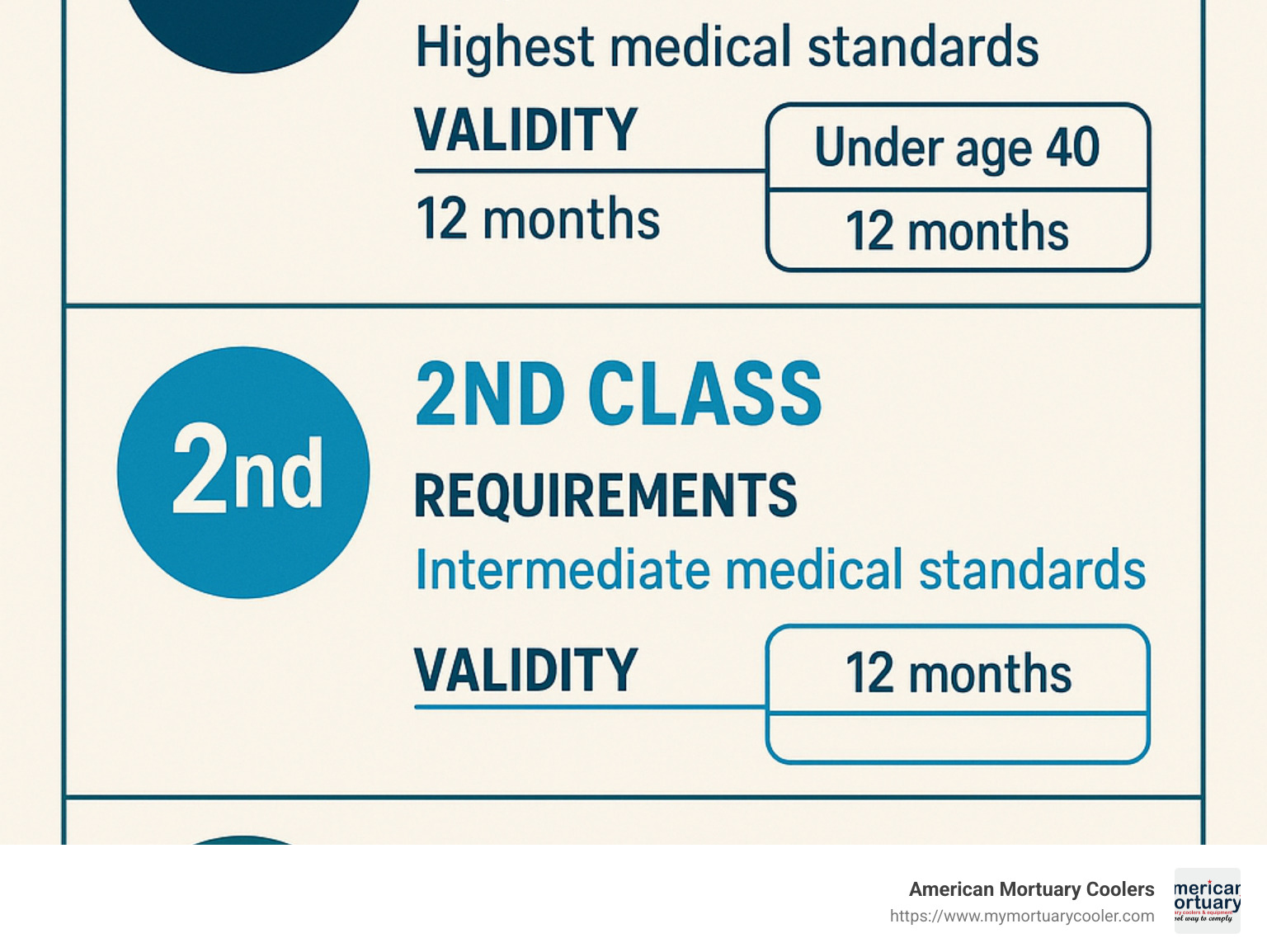
Aviation Medical Examiner 101: Roles, Certificates & Stats
Ever wondered who determines if pilots are medically fit to fly? That's where an Aviation Medical Examiner (AME) comes in. These aren't just any doctors – they're physicians specially designated by aviation authorities to perform flight physicals and issue medical certificates. In the United States, the Federal Aviation Administration (FAA) designates these physicians, though they work as private practitioners rather than federal employees.
The global aviation community depends on these medical gatekeepers to ensure pilots and air traffic controllers are healthy enough for safe operations. While the International Civil Aviation Organization sets baseline standards, many countries (including the US) implement more rigorous requirements.
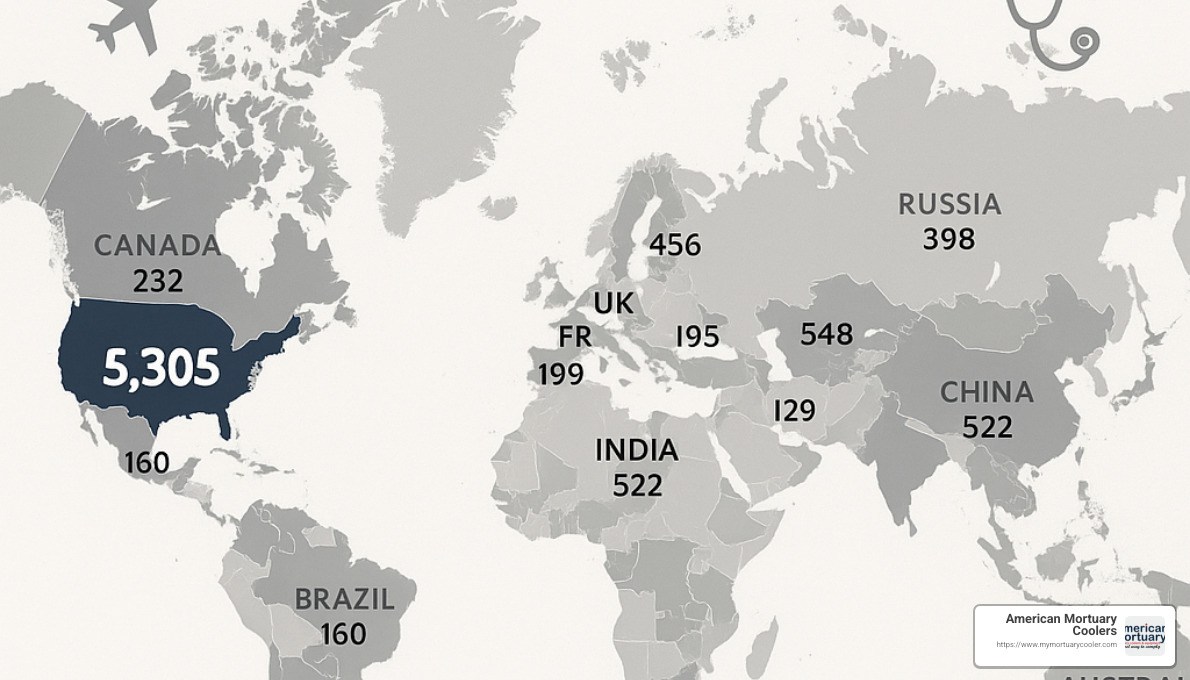
The numbers tell an interesting story: approximately 2,300 civilian Aviation Medical Examiners work across nine regions in the United States. Beyond our borders, 312 international AMEs operate in 81 countries, plus another 137 federal AMEs serving military personnel, Coast Guard members, NASA, and other government agencies. Together, this network conducts about 480,000 medical examinations annually for roughly 17,000 air traffic controllers and 640,000 pilots domestically and abroad.
What Does an Aviation Medical Examiner Do?
An aviation medical examiner serves as aviation's medical guardian. Their job goes beyond just basic check-ups – they're the front line of aviation safety through medical oversight.
Their primary responsibilities include conducting thorough flight physicals according to strict FAA standards and determining whether pilots and controllers meet medical requirements. They have the authority to issue medical certificates to qualified applicants, but must defer or deny certification when necessary. Many AMEs also monitor pilots with special medical conditions and maintain detailed records for FAA reporting.
As Dr. Charles A. Schuhmacher, who has performed aviation medicals since 1974, puts it: "We've built our reputation on excellence in aviation and aeromedical services, with a constant focus on safety and serving aviators."
It's worth noting that AMEs don't create or modify medical standards – they apply established FAA criteria. This ensures that pilots receive consistent evaluations regardless of which examiner they visit.
FAA Medical Certificate Classes at a Glance
The FAA issues three distinct classes of medical certificates, each tied to different types of flying:
First Class Medical Certificate is the most stringent and is required for Airline Transport Pilots (ATPs). For pilots under 40, it's valid for 12 months, while those 40 and older need to renew every 6 months. Only Senior AMEs – those with at least 3 years of experience – can issue these certificates.
Second Class Medical Certificate serves commercial pilots and has intermediate medical standards. It remains valid for 12 months regardless of the pilot's age.
Third Class Medical Certificate is for Private, Recreational, and Student Pilots. It has the least stringent requirements and stays valid for 5 years for pilots under 40, or 2 years for those 40 and older.
Newly designated AMEs can only perform Class II and III physicals initially. After three years of experience, they may be authorized to conduct Class I examinations for airline transport pilots.
By the Numbers: Where Are AMEs Located?
Aviation medical examiners aren't distributed evenly across the map. Their concentration typically reflects both population density and aviation activity. The FAA divides oversight into nine regions, each with its own Regional Flight Surgeon's Office supervising local AMEs.
The medical backgrounds of these physicians are surprisingly diverse. Family Practice doctors make up the majority at 56%, followed by Internal Medicine at 19%. General Surgery accounts for 7%, Aviation Medicine specialists 4%, Ophthalmologists 3%, and Psychiatrists 1%. The remaining 10% come from various other specialties. This diversity brings valuable perspective to the examination process, though all AMEs complete standardized FAA training regardless of their specialty background.
Not surprisingly, AME demand hotspots align with areas that have high pilot populations, major airline hubs, and flight training centers. The FAA strategically designates new examiners based on demonstrated need, ensuring pilots can find qualified medical examiners without traveling excessive distances.
For the latest information on FAA AME locator tools and resources, check out the official FAA AME locator page.
Hassle-Free Search: How to Find and Choose the Right Aviation Medical Examiner
Finding the right aviation medical examiner shouldn't give you a headache. Thankfully, there are several user-friendly tools that make this process as smooth as your favorite landing strip. The most trusted resource is the FAA's official AME directory, available through their Designee Locator tool – it's the gold standard for up-to-date examiner information.
If you're looking for something with a bit more pizzazz, FlightPhysical.com offers a more pilot-friendly experience. Their platform includes detailed AME profiles, convenient online scheduling, and even handles fee collection. I particularly like that they provide individual AME email addresses and websites, making that initial contact much easier.
When deciding which search tool works best for you, here's how they stack up:
| Feature | FAA Designee Locator | FlightPhysical.com |
|---|---|---|
| Official FAA data | Yes | Yes |
| Search by location | Yes | Yes |
| Mobile-friendly | Limited | Yes |
| AME profiles | Basic | Detailed |
| Online scheduling | No | Yes |
| User reviews | No | Yes |
| Fee information | No | Yes |
| HIMS AME filter | Yes | Yes |
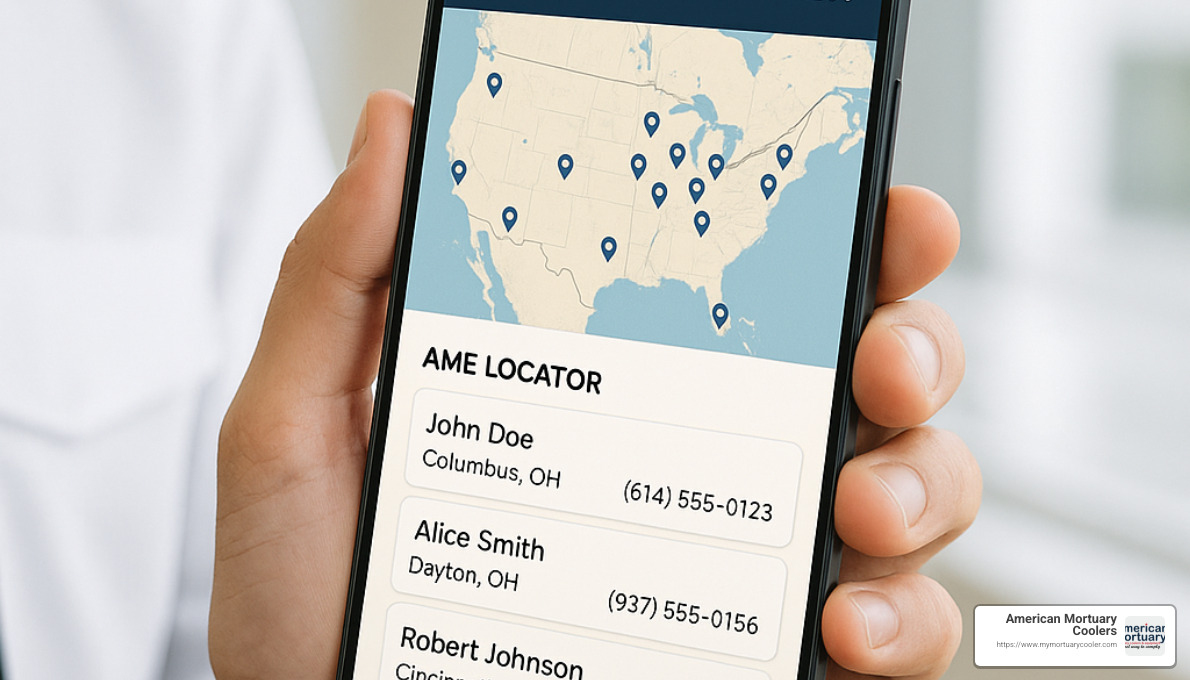
Step-by-Step Guide to Locating an Aviation Medical Examiner
Finding an aviation medical examiner is surprisingly straightforward when you break it down. First things first, complete your MedXPress application at https://medxpress.faa.gov/ before you even schedule an appointment. You'll get a confirmation number that your AME will need – think of it as your ticket to the exam.
Next, hop over to the FAA's Designee Locator at https://designee.faa.gov/ and select "AME" from the dropdown menu. Enter your ZIP code or city/state, and voilà – a list of nearby examiners appears like magic. You can filter these results based on how far you're willing to travel or whether you need special qualifications like HIMS certification.
Once you've found a few promising candidates, pick up the phone and call them directly. Ask if they're accepting new patients, verify their fees (they vary widely), and schedule your appointment. Don't forget to double-check the details – location, time, and any special instructions like fasting requirements or documents to bring along.
The FAA updates their locator regularly, so you can trust you're getting current information. No more showing up at an office only to find your AME has retired to the Bahamas!
Key Factors When Selecting Your AME
Choosing the right aviation medical examiner goes beyond finding the closest one to your home. Think of it like selecting a co-pilot – you want someone reliable who knows what they're doing.
If you need a First Class medical certificate, make sure your AME has senior authorization. Not all examiners can issue these high-level certificates, so check this first to avoid wasting a trip.
Look for an AME with aviation passion. Those who fly themselves or genuinely love aviation tend to understand pilot concerns better. As one pilot told me, "My AME is a weekend flyer too. He gets why certain medical issues worry me more than others."
Consider their examination volume. While AMEs only need to perform 10 exams yearly to keep their designation, those who do hundreds have seen it all. More experience typically means they're better equipped to handle complex cases or unexpected findings.
Don't underestimate the value of pilot reviews. Fellow aviators can tell you which AMEs are thorough but fair, and which might be overly strict or lax. Ask around at your local airport – pilots love sharing this kind of intel.
Be sure there's fee transparency before scheduling. Since the FAA doesn't regulate what AMEs charge, prices can range from $75 to $200+ for the same examination. Some offices also add fees for ECGs or other tests, so get the full picture upfront.
While location matters, sometimes driving an extra hour is worth it. As one seasoned pilot shared, "I drive 90 minutes to see my AME because his understanding of the FAA system has helped me maintain my medical despite developing hypertension. That extra drive time saves me countless headaches."
Special Searches: Finding a HIMS-Qualified AME
Sometimes you need an examiner with specialized training, particularly if you're dealing with substance-related issues or certain mental health conditions. This is where HIMS-qualified AMEs come in. The Human Intervention Motivation Study (HIMS) program focuses on helping pilots with these specific challenges return to flying safely.
Currently, about 200 aviation medical examiners in the U.S. hold HIMS qualification. These specialists not only perform medical exams but also provide essential sponsorship and monitoring for pilots returning to the cockpit after treatment.
Finding a HIMS AME is straightforward. You can use the regular FAA Designee Locator and simply check the HIMS qualification filter, or download a complete list directly from the FAA website in Word or PDF format. If you're having trouble finding one nearby, your Regional Flight Surgeon's office can point you in the right direction.
HIMS AMEs play a crucial dual role: they ensure aviation safety standards are maintained while also helping qualified pilots return to the career they love. Their specialized oversight creates a pathway back to the skies that might otherwise be permanently closed.
At American Mortuary Coolers, we understand the importance of specialized professionals who maintain strict standards while showing genuine care for the people they serve – whether in aviation medicine or our own field of mortuary equipment. Finding the right aviation medical examiner is just one step in ensuring our skies remain safe for everyone.
Inside the Exam: Preparation, Process & Special Issuances
Walking into your flight physical doesn't have to feel like stepping into the unknown. With proper preparation, your visit to an aviation medical examiner can be straightforward and stress-free. Think of your pre-exam prep as your pre-flight checklist—essential for a smooth experience.
Before your appointment, take time to complete the FAA's MedXPress application online at least 24 hours ahead. This electronic form (8500-8) replaces the old paper version, and you'll need to bring the confirmation number with you. It's also smart to familiarize yourself with FAA standards related to any medical conditions you have—the FAA website offers a handy "Standards-Your medical problem" tool that can help you understand potential certification problems before you arrive.
If you're managing any ongoing medical conditions, bring recent reports from your specialists. These documents can save you time and potentially prevent certification delays. And don't forget to verify that any medications you're taking are FAA-approved for pilots—many common prescriptions aren't compatible with flying duties.
"I always tell my patients to think of their AME visit as a partnership, not an interrogation," says Dr. James Wilson, a senior aviation medical examiner with 15 years of experience. "The more prepared you are, the better I can help you steer the certification process."
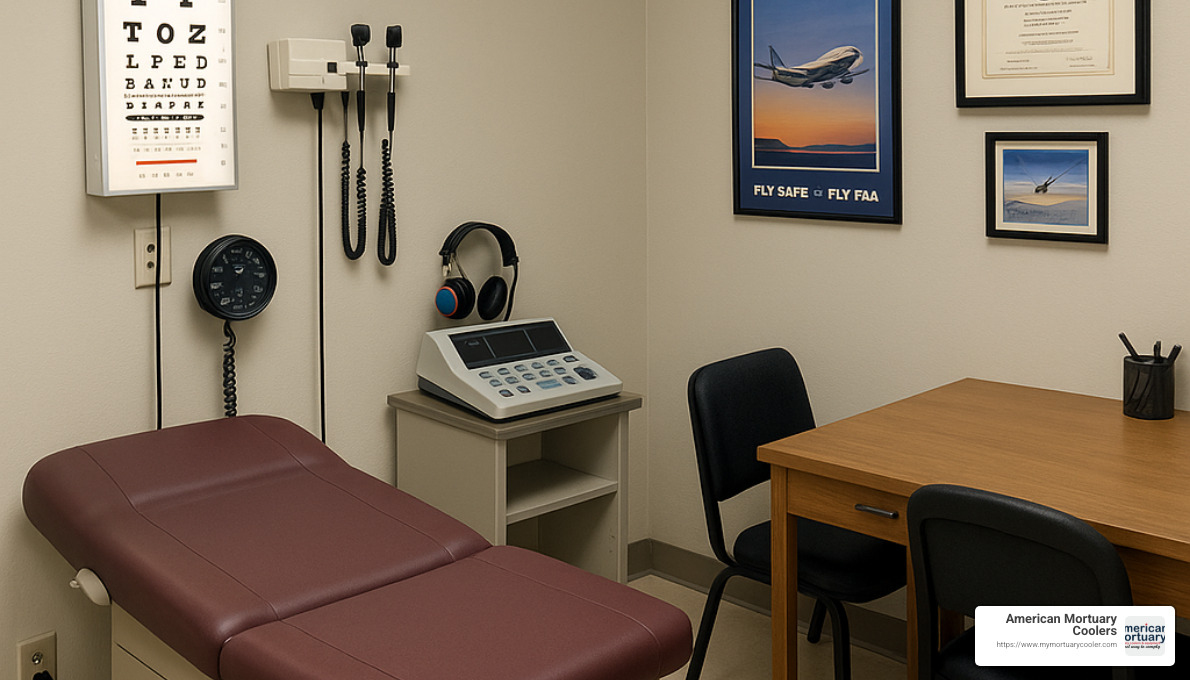
The Flight Physical From Check-In to Certificate
Your visit with an aviation medical examiner follows a predictable flow, much like a well-executed flight plan. After checking in and providing your MedXPress confirmation number, the AME will review your application and medical history—this is where your preparation pays off.
The vision test comes early in the exam, checking your near and distant vision, color perception, and field of vision. For those seeking First Class medicals, these standards are particularly stringent. Your hearing will also be assessed, either through a conversational test or a formal audiometric evaluation, depending on your certificate class.
The physical examination itself is comprehensive but efficient. Your AME will check your vital signs, examine your head, neck, and throat, assess your lungs and heart, evaluate your abdomen, and perform neurological and musculoskeletal assessments. For First Class applicants over 35, an electrocardiogram (ECG) is mandatory, with many modern AME offices offering on-site recording and direct transmission to the FAA.
Most pilots are pleasantly surprised by how quickly the exam progresses. "The whole process typically takes between 30 and 60 minutes," notes Dr. Sarah Chen, an aviation medical examiner in Portland. "The length really depends on your medical history and any conditions that might need additional attention."
If everything checks out, you'll walk away with your medical certificate in hand. If there are concerns, your AME might defer the decision to the FAA or request additional information—but a well-prepared pilot often avoids these delays.
Common Disqualifiers and How to Avoid Them
Understanding potential certification roadblocks can help you steer around them. Hypertension tops the list of common issues—the FAA generally requires blood pressure readings below 155/95. If you're borderline, consider skipping that morning coffee before your exam, arrive early to relax before your blood pressure check, and ensure the AME uses the correct cuff size for accurate measurement.
Medication concerns trip up many pilots. The FAA maintains a specific list of approved medications, and starting a new prescription without checking this list can lead to certification problems. When your doctor prescribes something new, a quick "Is this FAA-approved for pilots?" can save you significant headaches.
Vision standards vary by certificate class, but generally require 20/20 distant vision and 20/40 near vision in each eye (with or without correction), plus the ability to perceive aviation color signals. If you wear glasses or contacts, bring them along and make sure your prescription is current.
Mental health conditions require special attention but aren't automatic disqualifiers. Depression, anxiety, and ADHD often qualify for special issuance with proper documentation. The key is honesty—falsification of medical information carries severe consequences, including certificate revocation and potential legal action.
"Piloting aircraft is a privilege, not a right," reminds veteran pilot Michael Torres. "The medical standards exist to ensure both your safety and the safety of others who share the skies with you."
DUI/DWI history must be reported to the FAA and may trigger substance abuse evaluation. Prompt reporting and compliance with required assessments are essential. Similarly, heart conditions represent leading causes of medical denials, making regular preventive care crucial for maintaining your certification eligibility.
Special Issuance & BasicMed Pathways
When standard certification isn't possible, don't despair—alternative pathways exist. The Special Issuance process allows pilots with otherwise disqualifying conditions to fly if the FAA determines their condition is stable and properly managed. This typically requires detailed documentation from specialists, specific testing, and periodic re-evaluation.
"The Special Issuance process saved my career," shares Captain Rebecca Winters, who received her authorization after treatment for a medical condition. "It takes patience—sometimes several months—but for those who love flying, it's worth every bit of paperwork."
Since 2017, BasicMed has offered another option for pilots who previously held a valid FAA medical certificate (after July 14, 2006). Instead of visiting an AME, pilots can complete a physical with any state-licensed physician, have them complete the FAA's Comprehensive Medical Examination Checklist, and take an online medical education course.
BasicMed comes with operational limitations: aircraft under 6,000 pounds, no more than five passengers, speeds below 250 knots, and altitudes under 18,000 feet MSL. You'll need to renew the physical every 48 months and complete the online course every 24 months.
"BasicMed is perfect for recreational flying," explains weekend pilot James Chen. "It has simplified my medical certification process while still ensuring I'm fit to fly. For those of us who fly for fun rather than profession, it's been a game-changer."
For detailed scientific research on cardiovascular screening and how it relates to pilot certification, the extensive resources at WebMD offer valuable insights that complement FAA guidance.
Becoming & Staying an AME: Training, Legalities & Aviation Safety
For physicians with a passion for aviation and medicine, becoming an aviation medical examiner offers a unique way to contribute to flight safety. The journey isn't simple, though – the FAA carefully selects physicians based on regional needs, qualifications, and their commitment to keeping our skies safe.
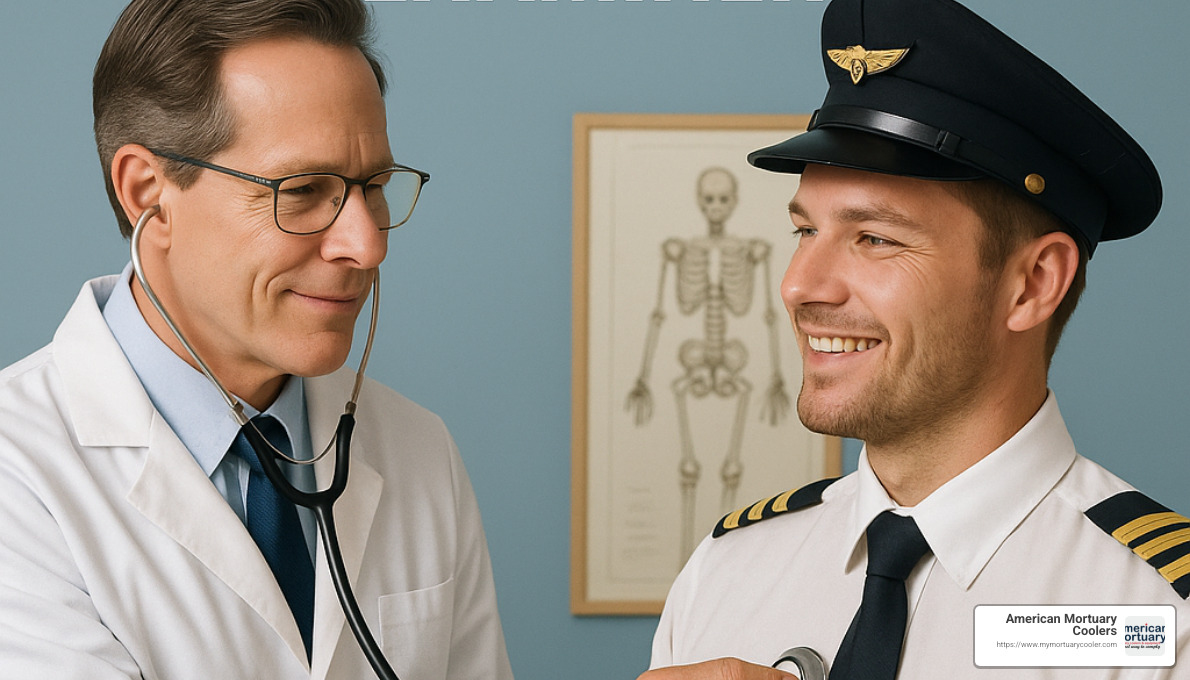
How Physicians Earn the Aviation Medical Examiner Title
The path to becoming an aviation medical examiner starts with credentials and connections. Physicians need a valid MD or DO license without restrictions – the foundation of their authority to evaluate pilots' fitness to fly.
Professional standing matters too. Applicants must provide three references from local physicians or a statement from their licensing authority that vouches for their professional reputation. After all, the FAA needs to know they're entrusting pilot health assessments to capable, ethical hands.
The journey begins in earnest with an application through the Regional Flight Surgeon's office. This isn't just a formality – the FAA carefully evaluates whether more AMEs are actually needed in the applicant's area. Not every qualified doctor gets approved, as the distribution needs to match pilot population demands.
If selected, physicians attend the Basic AME Seminar in Oklahoma City – an intensive 4½-day deep dive into aviation medicine. Offered quarterly, this training covers everything from regulatory requirements to examination procedures. It's where doctors learn to think like aviators as well as physicians.
Office equipment comes next. AMEs need specific tools to conduct thorough flight physicals according to exacting FAA standards. Only after training completion and verification of their qualifications do physicians receive their official AME designation.
"When I completed my AME training, I realized this wasn't just another credential – it was joining a community dedicated to keeping pilots and passengers safe," shares Dr. Lisa Chen, a family physician who became an AME five years ago.
Former military flight surgeons, physicians with prior AME experience, or those with aviation medicine expertise may receive special consideration, but the primary factor remains geographic need – the FAA wants pilots to have reasonable access to examiners no matter where they're based.
New AMEs start with limited authority, performing only Class II and Class III examinations. After gaining at least three years of experience, they can apply to become Senior AMEs with the authority to conduct Class I examinations for airline transport pilots.
Ongoing Requirements and Legal Considerations
Keeping that coveted AME designation requires ongoing effort and education. The FAA sets a minimum examination threshold of 10 physicals annually – a relatively low bar that ensures basic familiarity with the process but explains the wide variation in AME experience levels.
Continuing education keeps AMEs current. Every three years, they must attend a 2½-day Theme AME Seminar that provides updates on medical certification policies. These seminars aren't just regulatory hoops – they offer 26 AMA Category I CME credit hours, valuable for maintaining medical licensure too.
When it comes to legal status, aviation medical examiners occupy an interesting position. Though designated by the FAA, they aren't federal employees. They're private physicians with delegated authority, which has important implications for their practice:
Their examinations could potentially lead to malpractice claims, just like their regular medical work. While the FAA provides guidance on proper procedures, they don't offer legal representation if issues arise. The best protection? Following FAA protocols to the letter.
Unlike many medical services, the FAA doesn't dictate what AMEs can charge. Examiners set their own fees, which vary widely based on location, experience, and examination complexity. Pilots typically pay these fees out-of-pocket, as health insurance rarely covers aviation physicals.
"Being transparent about fees is part of building trust with the aviation community," notes Dr. James Wilson, who's been an AME for over a decade. "Pilots appreciate knowing exactly what to expect when they schedule their exam."
Why AMEs Are Crucial to the National Airspace System
Aviation medical examiners serve as the frontline guardians of aeromedical safety. By identifying and addressing medical conditions that could affect performance in the cockpit, they help prevent incidents before they happen – catching potential problems on the ground, not at 30,000 feet.
The standardized training AMEs receive ensures pilots receive consistent evaluations nationwide. Whether a pilot sees an examiner in Alaska or Florida, the same medical standards apply – creating a uniform safety net across the national airspace system.
Many AMEs go beyond simply conducting exams. They become trusted advisors to pilots, offering guidance on maintaining their medical qualification and addressing potential concerns proactively. This educational role helps pilots manage health issues before they become certification problems.
Through their examinations, AMEs also contribute valuable data. The information they collect helps the FAA understand pilot health trends, which informs policy development and safety initiatives that benefit the entire aviation community.
Dr. Michael J. White, an AME with over 10 years of emergency medicine experience, puts it perfectly: "Our role goes beyond simply approving or denying medical certificates. We're part of a comprehensive safety system that helps keep the skies safe for everyone."
At American Mortuary Coolers, we understand the importance of specialized professionals who maintain strict standards – whether in aviation safety or in our field of mortuary services. Though our industries differ, we share a commitment to excellence, safety, and professional development that serves the greater good.
Frequently Asked Questions & Conclusion
As we wrap up our comprehensive guide to finding an aviation medical examiner, let's address some of the most common questions pilots have about the medical certification process.
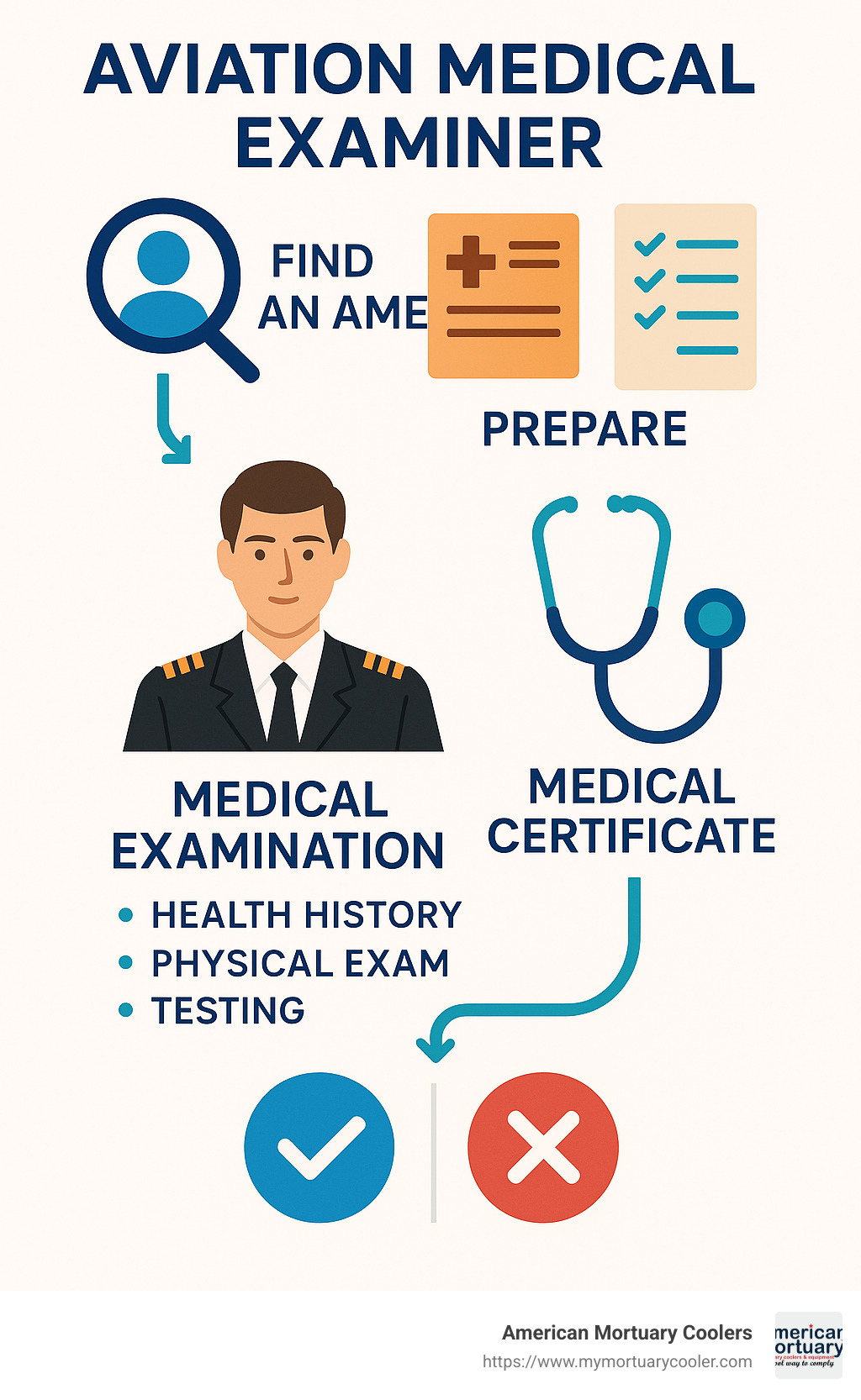
What documents should I bring to my AME appointment?
Walking into your AME appointment prepared will save you time and potential headaches. Your MedXPress confirmation number is absolutely essential—without it, your examiner can't access your application. Bring your government-issued photo ID so the AME can verify your identity.
If you wear glasses or contacts, don't forget to bring them along! Your AME will need to test your vision with your corrective lenses. A comprehensive list of all medications you're currently taking is crucial, as some medications can affect your certification status.
For pilots with existing medical conditions, bringing relevant medical records can streamline the process. If you've previously received a special issuance, that documentation is invaluable. And just in case your AME needs to contact your treating physicians, having their contact information handy can prevent delays.
BasicMed applicants should arrive with their completed Comprehensive Medical Examination Checklist and proof of their previous FAA medical certificate. Being thorough with your documentation shows your examiner you take the process seriously.
How often do I need to renew my medical certificate?
The timing of your medical certificate renewal depends on both the class of certificate and your age. For First Class Medical Certificates, pilots under 40 need to renew every 12 months, while those 40 and older face a more frequent 6-month renewal cycle.
Second Class Medical Certificate holders have it a bit simpler—everyone renews annually regardless of age. If you're flying with a Third Class Medical Certificate, you'll enjoy longer validity periods: 5 years if you're under 40, and 2 years if you're 40 or older.
Pilots flying under BasicMed rules need to complete a medical examination every 4 years and refresh their online medical course every 2 years.
Here's something many pilots don't realize: a First Class medical certificate doesn't simply expire—it actually "downgrades" to a Second Class certificate after the First Class duration expires, and then further downgrades to a Third Class certificate. This automatic downgrade can be helpful if your flying needs change over time.
Can I change doctors if my AME denies my certificate?
When an aviation medical examiner defers or denies your certificate, it's natural to wonder if you should seek a second opinion. However, simply finding another AME isn't the answer—and could land you in hot water.
Once an AME defers your application to the FAA, that information is recorded in their database. Attempting to visit another examiner without addressing the initial concern might be considered falsification, which carries severe consequences.
Instead, take a constructive approach. First, ask your AME to clearly explain why they deferred or denied your certificate. Armed with this knowledge, gather additional medical documentation that specifically addresses their concerns. Some AMEs specialize in difficult certification cases—these experienced examiners can be invaluable resources for navigating complex medical issues.
The goal isn't to circumvent the system but to work within it properly. The FAA has established channels for reconsideration and special issuance that can help qualified pilots return to the skies safely.
The stakes are high—falsifying information on your medical application can result in revocation of all your certificates and ratings, not to mention potential civil penalties. Honesty and transparency are always the best policy when it comes to aviation medical certification.
Conclusion & Takeoff
Finding the right aviation medical examiner is a journey that's now within your reach. With the FAA's official Designee Locator and specialized services like FlightPhysical.com at your fingertips, connecting with a qualified examiner who understands your specific needs has never been easier.
Your flight physical success starts with preparation. Complete your MedXPress application well in advance, gather all necessary documentation, and research potential AMEs thoroughly. Don't hesitate to travel a bit further for an examiner with specialized experience—especially if you have medical conditions that might complicate your certification.
Open communication with your AME creates a foundation for success. Many pilots find that being forthright about medical concerns actually helps them steer potential certification problems more smoothly.
At American Mortuary Coolers, we understand the importance of professional excellence and regulatory compliance. While our expertise lies in providing custom mortuary coolers and equipment across the contiguous 48 states, we recognize the striking parallels between our industry's exacting standards and those of aviation medicine. Both fields demand meticulous attention to detail, strict adherence to regulations, and an unwavering commitment to public safety.
We're proud to support aviation safety by providing this comprehensive guide for pilots navigating the medical certification process. Just as we deliver durable, custom solutions to funeral professionals nationwide, we hope this guide equips you with the knowledge you need to confidently approach your next flight physical.
Ready for your next certification? While we can't help with your flight physical, our team is always available to assist with your mortuary equipment needs. Visit our website for more industry resources and information about our custom solutions.
Safe flying and blue skies ahead!


















